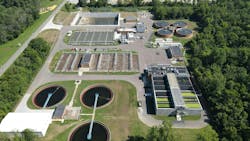Constructed in the mid 1950s, the Evansville, Indiana West Wastewater Treatment Plant receives flows from 31% of the city’s collection system.
The city has two watersheds divided by Pigeon Creek, a tributary of the Ohio River. In total, its wastewater treatment system comprises 900 miles of sewer of which 421 miles are sanitary. It takes two wastewater treatment plants to handle the flows from the service area: the East Plant and the West Plant.
West Plant Superintendent Jennifer Lindsey said the western facility has gone through several upgrades and iterations since that initial construction.
“We added the activated sludge treatment process in the early 1970s,” Lindsey said. “Then we added a biologically aerated filter in 2009. We serve an estimated population of 180,000 people, but we also have another plant on the east side.
CSOs, Continuous Improvement & Bug Health
Variability in flows, particularly during extreme and normal wet weather events had been an ongoing and consistent issue for the plant.
“One of the biggest issues we had in the past would be with storm sewer overflows or having manholes popping off because there’s just too much flow in the sewer system and nowhere for it to go,” Lindsey said.
The city constructed a 6 million gallon combined sewer overflow tank so the water would indeed have somewhere to go. Since that was constructed, Lindsey said overflows have been seldom and that the extra capacity has “worked out beautifully.”
When flows are that variable, however, it creates other complications, particularly with the bugs in the biological treatment processes at the plant. Ethan Elleser, Evansville Water & Sewer Utility biochemist, said this was an area of focus for him and for the utility’s continuous improvement efforts, particularly with the biologically aerated filter (BAF) system.
“We actually worked with Kruger and implemented a program type that — based on the influent flow — adds and subtracts cells,” Elleser said. “So if we get a rain event, then it’ll bring more cells on, and if we’re in July, then we’re not going to be running all 12 cells. We actually run eight cells.”
For years, the plant used chlorine gas disinfection. Lindsey said she became plant supervisor as the chlorine gas building was bulldozed and ultraviolet disinfection was installed and brought online. Elleser said this came with its own challenges, but made for a more robust treatment process in the end.
“UV is great because of the safety factor there. You’re not dealing with chlorine gas or hypochlorite,” he said, “but the bad thing is that if your particle size is too large in diameter, bacteria can hide out and make it past your screen."
Run of the Plant
Influent to the West Plant first passes through Aqua Caiman articulating rake screens from Parkson. After those rake screens, there is a diversion structure that allows the plant to divert high wet weather flows to the aforementioned 6 million gallon CSO tank.
Upon reaching the wet well after bar screens, the flow is pumped into the faciilty’s degritting system which is comprised of three grit classifiers. At the bottom of each classifier are Hydro International SlurryCups and GritSnail degritting equipment units.
After degritting, the plant uses enhanced primary clarification, which introduces a polyaluminum fluoride polymer to the wastewater. This is done in six rectangular tanks, which use a fiberglass flight for sludge collection. The effluent from th tank flows over V-notch weirs for flow utilization. The sludge collected from those clarifiers goes to the digesters at the plant. Three are primary and one is secondary, and each a a volume of 1 million gallons.
Because the West Plant does not have solids handling equipment, all the solids are then piped to the East Plant through a 5-mile pipe where it is dewatered and sent to a landfill.
Back to the primary clarifier effluent, the water flows through two secondary treatment technologies. One is a conventional activated sludge process, which consists of three parallel complete mix activated sludge trains. The other is a biologically aerated filter (BAF) system.
For the activated sludge process, water is fed from a spliter box that also acts as an equalization chamber and are mixed with three APG Neuros blowers. At the end of the aeration drain more polyaluminum fluoride is added for enhanced secondary clarification, which uses circular tanks that are peripherally fed.
The other of the secondary treatment technologies are biologically aerated filters from Veolia Water Technologies (formerly Kruger), which operates in fixed cells. Millions of 1 millimeter-diameter polystyrene beads fill the tanks in which water flows upward through them.
“They get pushed up against the concrete deck with nozzles in it,” Elleser said. “So once it is introduced to the biological media and it has had time to establish, it will actually filter and reduce soluble contaminants like ammonia, too.”
After the treatment, the water passes through Trojan UV disinfection units before it is discharged to the Ohio River.
Data, Data, Data
In search of addressing industrial pretreatment issues, Elleser said he was struck by a case study about a Frankfurt, Kentucky plant in which as solutions provider, Sentry, measured biochemical oxygen demand (BOD) in real time.
This technology uses a cathode and anode pair electrode plate that is submerged continuously in the wastewater flow. The cathode acts as an electron acceptor for the bacteria to grow on a biomass film, which can transmit respiration and consumption activity.
“That would then send a signal … to a panel for wastewater operators, plant managers and biochemists alike to be able to look at at all hours of the day and know what the strength of their incoming wastewater was,” Elleser said.
Given the West Plant’s history with industry, Elleser said the West Plant got two probes that report to a prebuilt dashboard. One probe is located as the water exits the grit removal system and the other leads the primary clarification process. Elleser said with some fine tuning for setting concentration and dilution limits. Now when there is an alarm, operators are confident it is real.
The next step for this sensor technology, Elleser said, is integrating a sampler that will allow the system to collect samples at any given time of the day.
“As you can imagine, that is a big different from getting in in the morning, and your aeration tanks are black, your effluent looks horrible, you don’t know what happened,” Elleser said. “You’re taking a sample then. Well, it already might have passed.”
That sampler will have a 24-sample-bottle carousel to take samples at discrete times when the signals are too high or too low. They will be timestamped for easy tracking against the dashboard, which will then be used to identify pretreatment problems at industrial sites in the city.
Location: Evansville, Indiana
Size: 21.7 MGD (average); 45 MGD (peak)
Equipment: Articulating rake screens, degritting system, enhanced primary clarification, conventional activated sludge, biologically aerated filtration, ultraviolet disinfection, continuous CBOD monitoring
About the Author
Bob Crossen
Bob Crossen is the editorial director for the Endeavor Business Media Water Group, which publishes WaterWorld, Wastewater Digest and Stormwater Solutions. Crossen graduated from Illinois State University in Dec. 2011 with a Bachelor of Arts in German and a Bachelor of Arts in Journalism. He worked for Campbell Publications, a weekly newspaper company in rural Illinois outside St. Louis for four years as a reporter and regional editor.

